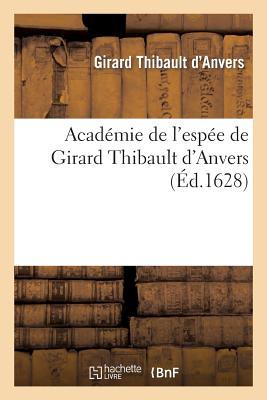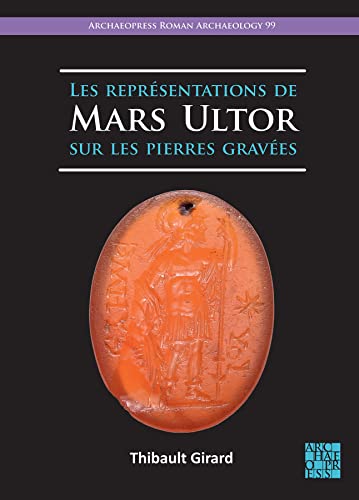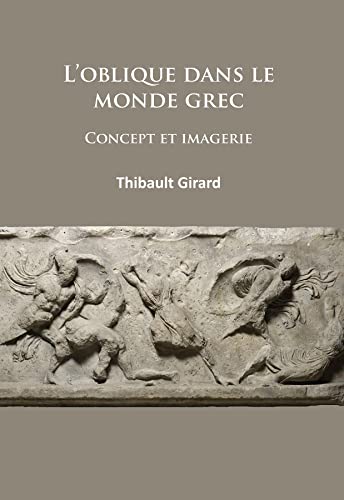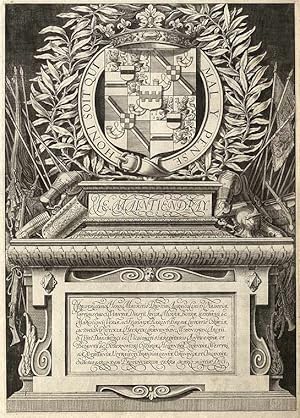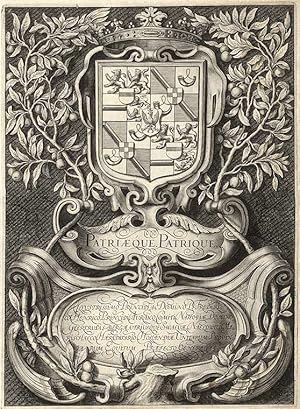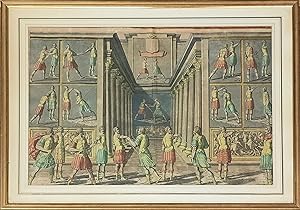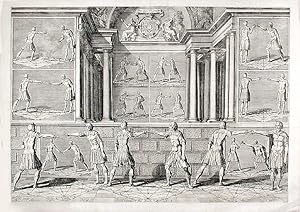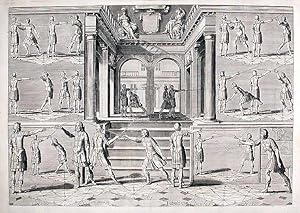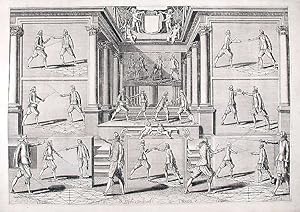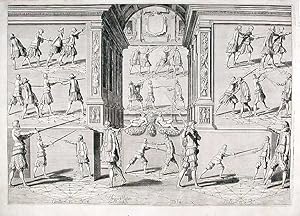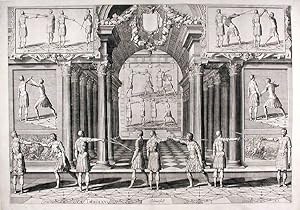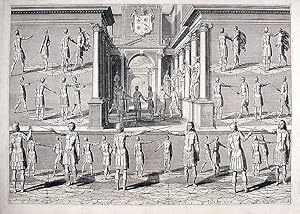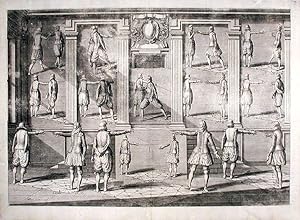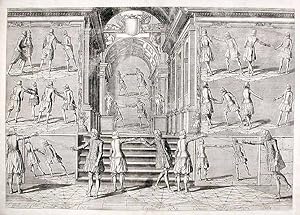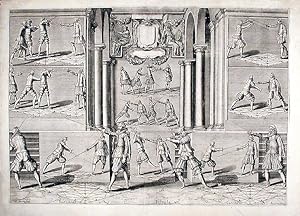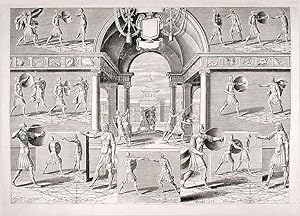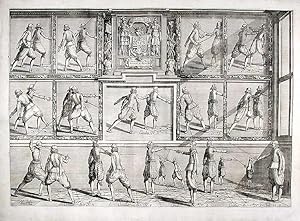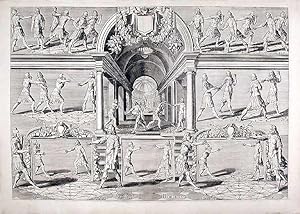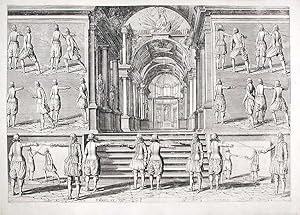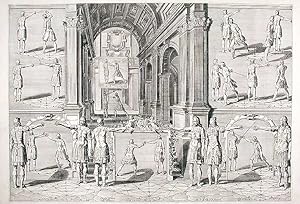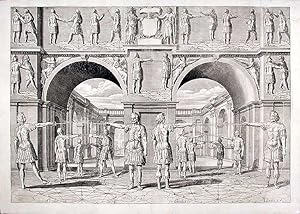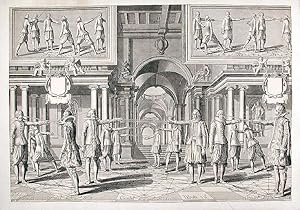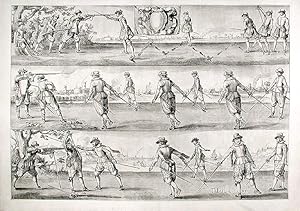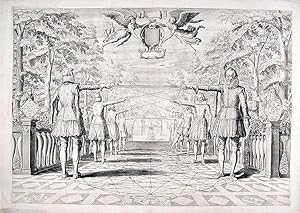thibault girard (59 résultats)
Type d'article
- Tous les types d'articles
- Livres (32)
- Magazines & Périodiques
- Bandes dessinées
- Partitions de musique
- Art, Affiches et Gravures (27)
- Photographies
- Cartes
-
Manuscrits &
Papiers anciens
Etat
Reliure
Particularités
- Edition originale (2)
- Signé
- Jaquette
- Avec images (36)
- Sans impression à la demande
Pays
Evaluation du vendeur
-
Acad�mie de l'esp�e de Girard Thibault d'Anvers (Paperback or Softback)
Edité par Hachette Livre Bnf 4/1/2013, 2013
ISBN 10 : 2012732755ISBN 13 : 9782012732759
Vendeur : BargainBookStores, Grand Rapids, MI, Etats-Unis
Livre
Paperback or Softback. Etat : New. Acad�mie de l'esp�e de Girard Thibault d'Anvers 2.42. Book.
Plus de choix d'achat de la part d'autres vendeurs sur AbeBooks
Offres neuf à partir de EUR 16,80
Offres d'occasion à partir de EUR 25,68
Trouvez également Couverture souple
-
Les Représentations De Mars Ultor Sur Les Pierres Gravées
Edité par Archaeopress, 2023
ISBN 10 : 180327509XISBN 13 : 9781803275093
Vendeur : GreatBookPrices, Columbia, MD, Etats-Unis
Livre
Etat : New.
Plus de choix d'achat de la part d'autres vendeurs sur AbeBooks
Offres neuf à partir de EUR 41,07
Offres d'occasion à partir de EUR 45,39
Trouvez également Couverture souple
-
L'Oblique Dans le Monde Grec: Concept et Imagerie
Edité par Archaeopress Archaeology, 2015
ISBN 10 : 1784911399ISBN 13 : 9781784911393
Vendeur : Revaluation Books, Exeter, Royaume-Uni
Livre
Paperback. Etat : Brand New. 189 pages. French language. 11.25x8.00x0.50 inches. In Stock.
Plus de choix d'achat de la part d'autres vendeurs sur AbeBooks
Offres neuf à partir de EUR 43,79
-
Fela Anikulapo Kuti. Rébellion Afrobeat
Edité par TEXTUEL, 2022
ISBN 10 : 2845979126ISBN 13 : 9782845979123
Vendeur : Gallix, Gif sur Yvette, France
Livre
Etat : Neuf.
-
Armorial Frontispiece from 'Academie de l'Espee'
Edité par B. & A. Elzevir, [Leiden, 1628
Vendeur : Donald A. Heald Rare Books (ABAA), New York, NY, Etats-Unis
Art / Affiche / Gravure
Copper engraving by ?Simon Van der Passe. Very good condition apart from a few small tears in the margins, a tinyhole in the lower left-hand corner of the image, and a few light foxing marks in the margins. A fine print from the most sumptuous book on fencing ever produced, which combines a strong design sense with beauty and historical importance, executed by one of the greatest engravers of the day. Thibault's work was produced during a period when the Italian rapier (or epee) held sway. "The Italians discovered the effectiveness of the dexterous use of the point rather than the edge of the sword. By the end of the 16th century, their lighter weapon.and simple, nimble, and controlled fencing style, emphasizing skill and speed rather than force, spread throughout Europe. Most of the wrestling tricks [used in earlier disciplines] were abandoned, the lunge was discovered, and fencing became established as an art" (Encyclopaedia Britannica). The present image marks the zenith of the use of the epee in Europe. "In the latter half of the 17th century, the sword and swordsmanship changed dramatically with a change in gentleman's dress. In France the court of Louis XIV set the fashion of silk stockings, breeches, and brocaded coats.As the long trailing rapier was unsuited to this form of dress, fashion decreed the wearing of a light, short court sword. The French style set in throughout Europe as the Italian had done earlier" (op. cit.). Cf. Vigeant p. 125; cf. Willems 302.
-
Armorial Frontispiece from 'Academie de l'Espee'
Edité par [Leiden: B. & A. Elzevir, 1628
Vendeur : Donald A. Heald Rare Books (ABAA), New York, NY, Etats-Unis
Art / Affiche / Gravure
Copper engraving by ?Simon Van der Passe. Very good condition apart from some overall light soiling and a small loss in the top margin. A fine print from the most sumptuous book on fencing ever produced, which combines a strong design sense with beauty and historical importance, executed by one of the greatest engravers of the day. Thibault's work was produced during a period when the Italian rapier (or epee) held sway. "The Italians discovered the effectiveness of the dexterous use of the point rather than the edge of the sword. By the end of the 16th century, their lighter weapon.and simple, nimble, and controlled fencing style, emphasizing skill and speed rather than force, spread throughout Europe. Most of the wrestling tricks [used in earlier disciplines] were abandoned, the lunge was discovered, and fencing became established as an art" (Encyclopaedia Britannica). The present image marks the zenith of the use of the epee in Europe. "In the latter half of the 17th century, the sword and swordsmanship changed dramatically with a change in gentleman's dress. In France the court of Louis XIV set the fashion of silk stockings, breeches, and brocaded coats.As the long trailing rapier was unsuited to this form of dress, fashion decreed the wearing of a light, short court sword. The French style set in throughout Europe as the Italian had done earlier" (op. cit.). Cf. Vigeant p. 125; cf. Willems 302.
-
tabula XII de l'Académie de l'épée
Date d'édition : 1628
Vendeur : SIX, TORCY, France
Art / Affiche / Gravure Edition originale
Pas de couverture. Etat : Très bon. Edition originale. ACADEMIE de l EPEE de Girard Thibault d Anvers de 1628 TABULA XII Gravure originale coloriée à la main de l'Académie de l'épée (Académie de l'épée : dans laquelle est démontrée par des règles mathématiques sur la base d'un cercle mystérieux la théorie et la pratique des véritables secrets jusqu'ici inconnus du maniement des armes à pied et à cheval) par Girard Thibault d Anvers (1574-1629) qui illustre La Destreza, l'école espagnole d'épée. Ces gravures illustrent comment une compréhension de la géométrie peut être appliquée aux mouvements et tactiques d'escrime en utilisant un cercle imaginaire entourant l'escrimeur. Autres gravures de l'académie de l'épée disponibles / Tabula : 6, 7, 12, 33 Gravure encadrée mais possible de retirer l'encadrement pour diminuer les frais de port à l'export Frais de port s'entendent sans l'encadrement ; avec l'encadrement frais plus élevés bien sûr.
-
Plate from 'Academie de l'Espee'
Edité par [Leiden: B. & A. Elzevir, 1628
Vendeur : Donald A. Heald Rare Books (ABAA), New York, NY, Etats-Unis
Art / Affiche / Gravure
Copper engraving by Johann Gelle. Very good condition apart from some mild creasing. A fine print from the most sumptuous book on fencing ever produced, which combines a strong design sense with beauty and historical importance, executed by one of the greatest engravers of the day. The image illustrates Thibault's theories of successful fencing using movement and mathematical principles. Thibault's work was produced during a period when the Italian rapier (or epee) held sway. "The Italians discovered the effectiveness of the dexterous use of the point rather than the edge of the sword. By the end of the 16th century, their lighter weapon.and simple, nimble, and controlled fencing style, emphasizing skill and speed rather than force, spread throughout Europe. Most of the wrestling tricks [used in earlier disciplines] were abandoned, the lunge was discovered, and fencing became established as an art" (Encyclopaedia Britannica). The present image marks the zenith of the use of the epee in Europe. "In the latter half of the 17th century, the sword and swordsmanship changed dramatically with a change in gentleman's dress. In France the court of Louis XIV set the fashion of silk stockings, breeches, and brocaded coats.As the long trailing rapier was unsuited to this form of dress, fashion decreed the wearing of a light, short court sword. The French style set in throughout Europe as the Italian had done earlier" (op. cit.). Cf. Vigeant p. 125; cf. Willems 302.
-
Plate from 'Academie de l'Espee'
Edité par [Leiden: B. & A. Elzevir, 1628
Vendeur : Donald A. Heald Rare Books (ABAA), New York, NY, Etats-Unis
Art / Affiche / Gravure
Copper engraving by Adrian Matham. Very good condition apart from several tears along the extreme edge of the top margin and a small brown spot in the top left-hand side of the image. A fine print from the most sumptuous book on fencing ever produced, which combines a strong design sense with beauty and historical importance, executed by one of the greatest engravers of the day. The image illustrates Thibault's theories of successful fencing using movement and mathematical principles. Thibault's work was produced during a period when the Italian rapier (or epee) held sway. "The Italians discovered the effectiveness of the dexterous use of the point rather than the edge of the sword. By the end of the 16th century, their lighter weapon.and simple, nimble, and controlled fencing style, emphasizing skill and speed rather than force, spread throughout Europe. Most of the wrestling tricks [used in earlier disciplines] were abandoned, the lunge was discovered, and fencing became established as an art" (Encyclopaedia Britannica). The present image marks the zenith of the use of the epee in Europe. "In the latter half of the 17th century, the sword and swordsmanship changed dramatically with a change in gentleman's dress. In France the court of Louis XIV set the fashion of silk stockings, breeches, and brocaded coats.As the long trailing rapier was unsuited to this form of dress, fashion decreed the wearing of a light, short court sword. The French style set in throughout Europe as the Italian had done earlier" (op. cit.). Cf. Vigeant p. 125; cf. Willems 302.
-
Plate from 'Academie de l'Espee'
Edité par [Leiden: B. & A. Elzevir, 1628
Vendeur : Donald A. Heald Rare Books (ABAA), New York, NY, Etats-Unis
Art / Affiche / Gravure
Copper engraving by Johann Gelle. Very good condition. A fine print from the most sumptuous book on fencing ever produced, which combines a strong design sense with beauty and historical importance, executed by one of the greatest engravers of the day. The image illustrates Thibault's theories of successful fencing using movement and mathematical principles. Thibault's work was produced during a period when the Italian rapier (or epee) held sway. "The Italians discovered the effectiveness of the dexterous use of the point rather than the edge of the sword. By the end of the 16th century, their lighter weapon.and simple, nimble, and controlled fencing style, emphasizing skill and speed rather than force, spread throughout Europe. Most of the wrestling tricks [used in earlier disciplines] were abandoned, the lunge was discovered, and fencing became established as an art" (Encyclopaedia Britannica). The present image marks the zenith of the use of the epee in Europe. "In the latter half of the 17th century, the sword and swordsmanship changed dramatically with a change in gentleman's dress. In France the court of Louis XIV set the fashion of silk stockings, breeches, and brocaded coats.As the long trailing rapier was unsuited to this form of dress, fashion decreed the wearing of a light, short court sword. The French style set in throughout Europe as the Italian had done earlier" (op. cit.). Cf. Vigeant p. 125; cf. Willems 302.
-
Plate from 'Academie de l'Espee'
Edité par [Leiden: B. & A. Elzevir, 1628
Vendeur : Donald A. Heald Rare Books (ABAA), New York, NY, Etats-Unis
Art / Affiche / Gravure
Copper engraving by 'Rob. beaudoux'. Very good condition apart from some mild rippling. A fine print from the most sumptuous book on fencing ever produced, which combines a strong design sense with beauty and historical importance, executed by one of the greatest engravers of the day. The image illustrates Thibault's theories of successful fencing using movement and mathematical principles. Thibault's work was produced during a period when the Italian rapier (or epee) held sway. "The Italians discovered the effectiveness of the dexterous use of the point rather than the edge of the sword. By the end of the 16th century, their lighter weapon.and simple, nimble, and controlled fencing style, emphasizing skill and speed rather than force, spread throughout Europe. Most of the wrestling tricks [used in earlier disciplines] were abandoned, the lunge was discovered, and fencing became established as an art" (Encyclopaedia Britannica). The present image marks the zenith of the use of the epee in Europe. "In the latter half of the 17th century, the sword and swordsmanship changed dramatically with a change in gentleman's dress. In France the court of Louis XIV set the fashion of silk stockings, breeches, and brocaded coats.As the long trailing rapier was unsuited to this form of dress, fashion decreed the wearing of a light, short court sword. The French style set in throughout Europe as the Italian had done earlier" (op. cit.). Cf. Vigeant p. 125; cf. Willems 302.
-
Plate from 'Academie de l'Espee'
Edité par [Leiden: B. & A. Elzevir, 1628
Vendeur : Donald A. Heald Rare Books (ABAA), New York, NY, Etats-Unis
Art / Affiche / Gravure
Copper engraving by Pieter van Serwouters. Very good condition. A fine print from the most sumptuous book on fencing ever produced, which combines a strong design sense with beauty and historical importance, executed by one of the greatest engravers of the day. The image illustrates Thibault's theories of successful fencing using movement and mathematical principles. Thibault's work was produced during a period when the Italian rapier (or epee) held sway. "The Italians discovered the effectiveness of the dexterous use of the point rather than the edge of the sword. By the end of the 16th century, their lighter weapon.and simple, nimble, and controlled fencing style, emphasizing skill and speed rather than force, spread throughout Europe. Most of the wrestling tricks [used in earlier disciplines] were abandoned, the lunge was discovered, and fencing became established as an art" (Encyclopaedia Britannica). The present image marks the zenith of the use of the epee in Europe. "In the latter half of the 17th century, the sword and swordsmanship changed dramatically with a change in gentleman's dress. In France the court of Louis XIV set the fashion of silk stockings, breeches, and brocaded coats.As the long trailing rapier was unsuited to this form of dress, fashion decreed the wearing of a light, short court sword. The French style set in throughout Europe as the Italian had done earlier" (op. cit.). Cf. Vigeant p. 125; cf. Willems 302.
-
Plate from 'Academie de l'Espee'
Edité par [Leiden: B. & A. Elzevir, 1628
Vendeur : Donald A. Heald Rare Books (ABAA), New York, NY, Etats-Unis
Art / Affiche / Gravure
Copper engraving by Pieter van Serwouters. Very good condition apart from a few light foxing marks in the bottom margin. A fine print from the most sumptuous book on fencing ever produced, which combines a strong design sense with beauty and historical importance, executed by one of the greatest engravers of the day. The image illustrates Thibault's theories of successful fencing using movement and mathematical principles. Thibault's work was produced during a period when the Italian rapier (or epee) held sway. "The Italians discovered the effectiveness of the dexterous use of the point rather than the edge of the sword. By the end of the 16th century, their lighter weapon.and simple, nimble, and controlled fencing style, emphasizing skill and speed rather than force, spread throughout Europe. Most of the wrestling tricks [used in earlier disciplines] were abandoned, the lunge was discovered, and fencing became established as an art" (Encyclopaedia Britannica). The present image marks the zenith of the use of the epee in Europe. "In the latter half of the 17th century, the sword and swordsmanship changed dramatically with a change in gentleman's dress. In France the court of Louis XIV set the fashion of silk stockings, breeches, and brocaded coats.As the long trailing rapier was unsuited to this form of dress, fashion decreed the wearing of a light, short court sword. The French style set in throughout Europe as the Italian had done earlier" (op. cit.). Cf. Vigeant p. 125; cf. Willems 302.
-
Plate from 'Academie de l'Espee'
Edité par [Leiden: B. & A. Elzevir, 1628
Vendeur : Donald A. Heald Rare Books (ABAA), New York, NY, Etats-Unis
Art / Affiche / Gravure
Copper engraving by Nicolas Petri Lastman. Very good condition apart from a few skillfully repaired losses in the margins and several tears in the top margin. A fine print from the most sumptuous book on fencing ever produced, which combines a strong design sense with beauty and historical importance, executed by one of the greatest engravers of the day. The image illustrates Thibault's theories of successful fencing using movement and mathematical principles. Thibault's work was produced during a period when the Italian rapier (or epee) held sway. "The Italians discovered the effectiveness of the dexterous use of the point rather than the edge of the sword. By the end of the 16th century, their lighter weapon.and simple, nimble, and controlled fencing style, emphasizing skill and speed rather than force, spread throughout Europe. Most of the wrestling tricks [used in earlier disciplines] were abandoned, the lunge was discovered, and fencing became established as an art" (Encyclopaedia Britannica). The present image marks the zenith of the use of the epee in Europe. "In the latter half of the 17th century, the sword and swordsmanship changed dramatically with a change in gentleman's dress. In France the court of Louis XIV set the fashion of silk stockings, breeches, and brocaded coats.As the long trailing rapier was unsuited to this form of dress, fashion decreed the wearing of a light, short court sword. The French style set in throughout Europe as the Italian had done earlier" (op. cit.). Cf. Vigeant p. 125; cf. Willems 302.
-
Plate from 'Academie de l'Espee'
Edité par [Leiden: B. & A. Elzevir, 1628
Vendeur : Donald A. Heald Rare Books (ABAA), New York, NY, Etats-Unis
Art / Affiche / Gravure
Copper engraving by Johann Gelle. Very good condition apart from a 4 1/2" loss in the bottom margin and several small tears at the extreme edge of the top margin. A fine print from the most sumptuous book on fencing ever produced, which combines a strong design sense with beauty and historical importance, executed by one of the greatest engravers of the day. The image illustrates Thibault's theories of successful fencing using movement and mathematical principles. Thibault's work was produced during a period when the Italian rapier (or epee) held sway. "The Italians discovered the effectiveness of the dexterous use of the point rather than the edge of the sword. By the end of the 16th century, their lighter weapon.and simple, nimble, and controlled fencing style, emphasizing skill and speed rather than force, spread throughout Europe. Most of the wrestling tricks [used in earlier disciplines] were abandoned, the lunge was discovered, and fencing became established as an art" (Encyclopaedia Britannica). The present image marks the zenith of the use of the epee in Europe. "In the latter half of the 17th century, the sword and swordsmanship changed dramatically with a change in gentleman's dress. In France the court of Louis XIV set the fashion of silk stockings, breeches, and brocaded coats.As the long trailing rapier was unsuited to this form of dress, fashion decreed the wearing of a light, short court sword. The French style set in throughout Europe as the Italian had done earlier" (op. cit.). Cf. Vigeant p. 125; cf. Willems 302.
-
Plate from 'Academie de l'Espee'
Edité par [Leiden: B. & A. Elzevir, 1628
Vendeur : Donald A. Heald Rare Books (ABAA), New York, NY, Etats-Unis
Art / Affiche / Gravure
Copper engraving by Johann Gelle. Very good condition apart from several skillfully repaired losses in the margins. A fine print from the most sumptuous book on fencing ever produced, which combines a strong design sense with beauty and historical importance, executed by one of the greatest engravers of the day. The image illustrates Thibault's theories of successful fencing using movement and mathematical principles. Thibault's work was produced during a period when the Italian rapier (or epee) held sway. "The Italians discovered the effectiveness of the dexterous use of the point rather than the edge of the sword. By the end of the 16th century, their lighter weapon.and simple, nimble, and controlled fencing style, emphasizing skill and speed rather than force, spread throughout Europe. Most of the wrestling tricks [used in earlier disciplines] were abandoned, the lunge was discovered, and fencing became established as an art" (Encyclopaedia Britannica). The present image marks the zenith of the use of the epee in Europe. "In the latter half of the 17th century, the sword and swordsmanship changed dramatically with a change in gentleman's dress. In France the court of Louis XIV set the fashion of silk stockings, breeches, and brocaded coats.As the long trailing rapier was unsuited to this form of dress, fashion decreed the wearing of a light, short court sword. The French style set in throughout Europe as the Italian had done earlier" (op. cit.). Cf. Vigeant p. 125; cf. Willems 302.
-
Plate from 'Academie de l'Espee'
Edité par [Leiden: B. & A. Elzevir, 1628
Vendeur : Donald A. Heald Rare Books (ABAA), New York, NY, Etats-Unis
Art / Affiche / Gravure
Copper engraving by Peter Isselburg. Very good condition apart from a few several skillfully repaired losses in the top margin, several small tears at the extreme edges of the margins, and an orange spot in the center of the image. A fine print from the most sumptuous book on fencing ever produced, which combines a strong design sense with beauty and historical importance, executed by one of the greatest engravers of the day. The image illustrates Thibault's theories of successful fencing using movement and mathematical principles. Thibault's work was produced during a period when the Italian rapier (or epee) held sway. "The Italians discovered the effectiveness of the dexterous use of the point rather than the edge of the sword. By the end of the 16th century, their lighter weapon.and simple, nimble, and controlled fencing style, emphasizing skill and speed rather than force, spread throughout Europe. Most of the wrestling tricks [used in earlier disciplines] were abandoned, the lunge was discovered, and fencing became established as an art" (Encyclopaedia Britannica). The present image marks the zenith of the use of the epee in Europe. "In the latter half of the 17th century, the sword and swordsmanship changed dramatically with a change in gentleman's dress. In France the court of Louis XIV set the fashion of silk stockings, breeches, and brocaded coats.As the long trailing rapier was unsuited to this form of dress, fashion decreed the wearing of a light, short court sword. The French style set in throughout Europe as the Italian had done earlier" (op. cit.). Cf. Vigeant p. 125; cf. Willems 302.
-
Plate from 'Academie de l'Espee'
Edité par [Leiden: B. & A. Elzevir, 1628
Vendeur : Donald A. Heald Rare Books (ABAA), New York, NY, Etats-Unis
Art / Affiche / Gravure
Copper engraving by Andries Jacobsz Stock. Very good condition apart from a few light foxing marks in the top margin. A fine print from the most sumptuous book on fencing ever produced, which combines a strong design sense with beauty and historical importance, executed by one of the greatest engravers of the day. The image illustrates Thibault's theories of successful fencing using movement and mathematical principles. Thibault's work was produced during a period when the Italian rapier (or epee) held sway. "The Italians discovered the effectiveness of the dexterous use of the point rather than the edge of the sword. By the end of the 16th century, their lighter weapon.and simple, nimble, and controlled fencing style, emphasizing skill and speed rather than force, spread throughout Europe. Most of the wrestling tricks [used in earlier disciplines] were abandoned, the lunge was discovered, and fencing became established as an art" (Encyclopaedia Britannica). The present image marks the zenith of the use of the epee in Europe. "In the latter half of the 17th century, the sword and swordsmanship changed dramatically with a change in gentleman's dress. In France the court of Louis XIV set the fashion of silk stockings, breeches, and brocaded coats.As the long trailing rapier was unsuited to this form of dress, fashion decreed the wearing of a light, short court sword. The French style set in throughout Europe as the Italian had done earlier" (op. cit.). Cf. Vigeant p. 125; cf. Willems 302.
-
Plate from 'Academie de l'Espee'
Edité par [Leiden: B. & A. Elzevir, 1628
Vendeur : Donald A. Heald Rare Books (ABAA), New York, NY, Etats-Unis
Art / Affiche / Gravure
Copper engraving by 'Rob. beaudoux'. Very good condition apart from a small loss in the lower right corner, a few skillfully repaired tears in the top margin, and several small tears at the extreme edge of the bottom margin. A fine print from the most sumptuous book on fencing ever produced, which combines a strong design sense with beauty and historical importance, executed by one of the greatest engravers of the day. The image illustrates Thibault's theories of successful fencing using movement and mathematical principles. Thibault's work was produced during a period when the Italian rapier (or epee) held sway. "The Italians discovered the effectiveness of the dexterous use of the point rather than the edge of the sword. By the end of the 16th century, their lighter weapon.and simple, nimble, and controlled fencing style, emphasizing skill and speed rather than force, spread throughout Europe. Most of the wrestling tricks [used in earlier disciplines] were abandoned, the lunge was discovered, and fencing became established as an art" (Encyclopaedia Britannica). The present image marks the zenith of the use of the epee in Europe. "In the latter half of the 17th century, the sword and swordsmanship changed dramatically with a change in gentleman's dress. In France the court of Louis XIV set the fashion of silk stockings, breeches, and brocaded coats.As the long trailing rapier was unsuited to this form of dress, fashion decreed the wearing of a light, short court sword. The French style set in throughout Europe as the Italian had done earlier" (op. cit.). Cf. Vigeant p. 125; cf. Willems 302.
-
Plate from 'Academie de l'Espee'
Edité par [Leiden: B. & A. Elzevir, 1628
Vendeur : Donald A. Heald Rare Books (ABAA), New York, NY, Etats-Unis
Art / Affiche / Gravure
Copper engraving Crispyn Van den Queborne. Very good condition. A fine print from the most sumptuous book on fencing ever produced, which combines a strong design sense with beauty and historical importance, executed by one of the greatest engravers of the day. The image illustrates Thibault's theories of successful fencing using movement and mathematical principles. Thibault's work was produced during a period when the Italian rapier (or epee) held sway. "The Italians discovered the effectiveness of the dexterous use of the point rather than the edge of the sword. By the end of the 16th century, their lighter weapon.and simple, nimble, and controlled fencing style, emphasizing skill and speed rather than force, spread throughout Europe. Most of the wrestling tricks [used in earlier disciplines] were abandoned, the lunge was discovered, and fencing became established as an art" (Encyclopaedia Britannica). The present image marks the zenith of the use of the epee in Europe. "In the latter half of the 17th century, the sword and swordsmanship changed dramatically with a change in gentleman's dress. In France the court of Louis XIV set the fashion of silk stockings, breeches, and brocaded coats.As the long trailing rapier was unsuited to this form of dress, fashion decreed the wearing of a light, short court sword. The French style set in throughout Europe as the Italian had done earlier" (op. cit.). Cf. Vigeant p. 125; cf. Willems 302.
-
Plate from 'Academie de l'Espee'
Edité par [Leiden: B. & A. Elzevir, 1628
Vendeur : Donald A. Heald Rare Books (ABAA), New York, NY, Etats-Unis
Art / Affiche / Gravure
Copper engraving by Egbert van Panderen. Very good condition. A fine print from the most sumptuous book on fencing ever produced, which combines a strong design sense with beauty and historical importance, executed by one of the greatest engravers of the day. The image illustrates Thibault's theories of successful fencing using movement and mathematical principles. Thibault's work was produced during a period when the Italian rapier (or epee) held sway. "The Italians discovered the effectiveness of the dexterous use of the point rather than the edge of the sword. By the end of the 16th century, their lighter weapon.and simple, nimble, and controlled fencing style, emphasizing skill and speed rather than force, spread throughout Europe. Most of the wrestling tricks [used in earlier disciplines] were abandoned, the lunge was discovered, and fencing became established as an art" (Encyclopaedia Britannica). The present image marks the zenith of the use of the epee in Europe. "In the latter half of the 17th century, the sword and swordsmanship changed dramatically with a change in gentleman's dress. In France the court of Louis XIV set the fashion of silk stockings, breeches, and brocaded coats.As the long trailing rapier was unsuited to this form of dress, fashion decreed the wearing of a light, short court sword. The French style set in throughout Europe as the Italian had done earlier" (op. cit.). Cf. Vigeant p. 125; cf. Willems 302.
-
Plate from 'Academie de l'Espee'
Edité par [Leiden: B. & A. Elzevir, 1628
Vendeur : Donald A. Heald Rare Books (ABAA), New York, NY, Etats-Unis
Art / Affiche / Gravure
Copper engraving by Schelte Adams Bolswert. Very good condition apart from several skillfully repaired losses and tears in the margins. A fine print from the most sumptuous book on fencing ever produced, which combines a strong design sense with beauty and historical importance, executed by one of the greatest engravers of the day. The image illustrates Thibault's theories of successful fencing using movement and mathematical principles. Thibault's work was produced during a period when the Italian rapier (or epee) held sway. "The Italians discovered the effectiveness of the dexterous use of the point rather than the edge of the sword. By the end of the 16th century, their lighter weapon.and simple, nimble, and controlled fencing style, emphasizing skill and speed rather than force, spread throughout Europe. Most of the wrestling tricks [used in earlier disciplines] were abandoned, the lunge was discovered, and fencing became established as an art" (Encyclopaedia Britannica). The present image marks the zenith of the use of the epee in Europe. "In the latter half of the 17th century, the sword and swordsmanship changed dramatically with a change in gentleman's dress. In France the court of Louis XIV set the fashion of silk stockings, breeches, and brocaded coats.As the long trailing rapier was unsuited to this form of dress, fashion decreed the wearing of a light, short court sword. The French style set in throughout Europe as the Italian had done earlier" (op. cit.). Cf. Vigeant p. 125; cf. Willems 302.
-
Plate from 'Academie de l'Espee'
Edité par [Leiden: B. & A. Elzevir, 1628
Vendeur : Donald A. Heald Rare Books (ABAA), New York, NY, Etats-Unis
Art / Affiche / Gravure
Copper engraving Andries Jacobsz Stock. Very good condition. A fine print from the most sumptuous book on fencing ever produced, which combines a strong design sense with beauty and historical importance, executed by one of the greatest engravers of the day. The image illustrates Thibault's theories of successful fencing using movement and mathematical principles. Thibault's work was produced during a period when the Italian rapier (or epee) held sway. "The Italians discovered the effectiveness of the dexterous use of the point rather than the edge of the sword. By the end of the 16th century, their lighter weapon.and simple, nimble, and controlled fencing style, emphasizing skill and speed rather than force, spread throughout Europe. Most of the wrestling tricks [used in earlier disciplines] were abandoned, the lunge was discovered, and fencing became established as an art" (Encyclopaedia Britannica). The present image marks the zenith of the use of the epee in Europe. "In the latter half of the 17th century, the sword and swordsmanship changed dramatically with a change in gentleman's dress. In France the court of Louis XIV set the fashion of silk stockings, breeches, and brocaded coats.As the long trailing rapier was unsuited to this form of dress, fashion decreed the wearing of a light, short court sword. The French style set in throughout Europe as the Italian had done earlier" (op. cit.). Cf. Vigeant p. 125; cf. Willems 302.
-
Plate from 'Academie de l'Espee'
Edité par [Leiden: B. & A. Elzevir, 1628
Vendeur : Donald A. Heald Rare Books (ABAA), New York, NY, Etats-Unis
Art / Affiche / Gravure
Copper engraving by Crispyn Van den Queborne. Very good condition apart from some light foxing in the margins. A fine print from the most sumptuous book on fencing ever produced, which combines a strong design sense with beauty and historical importance, executed by one of the greatest engravers of the day. The image illustrates Thibault's theories of successful fencing using movement and mathematical principles. Thibault's work was produced during a period when the Italian rapier (or epee) held sway. "The Italians discovered the effectiveness of the dexterous use of the point rather than the edge of the sword. By the end of the 16th century, their lighter weapon.and simple, nimble, and controlled fencing style, emphasizing skill and speed rather than force, spread throughout Europe. Most of the wrestling tricks [used in earlier disciplines] were abandoned, the lunge was discovered, and fencing became established as an art" (Encyclopaedia Britannica). The present image marks the zenith of the use of the epee in Europe. "In the latter half of the 17th century, the sword and swordsmanship changed dramatically with a change in gentleman's dress. In France the court of Louis XIV set the fashion of silk stockings, breeches, and brocaded coats.As the long trailing rapier was unsuited to this form of dress, fashion decreed the wearing of a light, short court sword. The French style set in throughout Europe as the Italian had done earlier" (op. cit.). Cf. Vigeant p. 125; cf. Willems 302.
-
Plate from 'Academie de l'Espee'
Edité par [Leiden: B. & A. Elzevir, 1628
Vendeur : Donald A. Heald Rare Books (ABAA), New York, NY, Etats-Unis
Art / Affiche / Gravure
Copper engraving by Willem Jacobsz Delff. Very good condition apart from a skillfully repaired 5/8" tear in the top margin. A fine print from the most sumptuous book on fencing ever produced, which combines a strong design sense with beauty and historical importance, executed by one of the greatest engravers of the day. The image illustrates Thibault's theories of successful fencing using movement and mathematical principles. Thibault's work was produced during a period when the Italian rapier (or epee) held sway. "The Italians discovered the effectiveness of the dexterous use of the point rather than the edge of the sword. By the end of the 16th century, their lighter weapon.and simple, nimble, and controlled fencing style, emphasizing skill and speed rather than force, spread throughout Europe. Most of the wrestling tricks [used in earlier disciplines] were abandoned, the lunge was discovered, and fencing became established as an art" (Encyclopaedia Britannica). The present image marks the zenith of the use of the epee in Europe. "In the latter half of the 17th century, the sword and swordsmanship changed dramatically with a change in gentleman's dress. In France the court of Louis XIV set the fashion of silk stockings, breeches, and brocaded coats.As the long trailing rapier was unsuited to this form of dress, fashion decreed the wearing of a light, short court sword. The French style set in throughout Europe as the Italian had done earlier" (op. cit.). Cf. Vigeant p. 125; cf. Willems 302.
-
Plate from 'Academie de l'Espee'
Edité par [Leiden: B. & A. Elzevir, 1628
Vendeur : Donald A. Heald Rare Books (ABAA), New York, NY, Etats-Unis
Art / Affiche / Gravure
Copper engraving by Nicolas Petri Lastman. Very good condition apart from some mild creasing and a small orange spot in the lower right side of the image near the plate number. A fine print from the most sumptuous book on fencing ever produced, which combines a strong design sense with beauty and historical importance, executed by one of the greatest engravers of the day. The image illustrates Thibault's theories of successful fencing using movement and mathematical principles. Thibault's work was produced during a period when the Italian rapier (or epee) held sway. "The Italians discovered the effectiveness of the dexterous use of the point rather than the edge of the sword. By the end of the 16th century, their lighter weapon.and simple, nimble, and controlled fencing style, emphasizing skill and speed rather than force, spread throughout Europe. Most of the wrestling tricks [used in earlier disciplines] were abandoned, the lunge was discovered, and fencing became established as an art" (Encyclopaedia Britannica). The present image marks the zenith of the use of the epee in Europe. "In the latter half of the 17th century, the sword and swordsmanship changed dramatically with a change in gentleman's dress. In France the court of Louis XIV set the fashion of silk stockings, breeches, and brocaded coats.As the long trailing rapier was unsuited to this form of dress, fashion decreed the wearing of a light, short court sword. The French style set in throughout Europe as the Italian had done earlier" (op. cit.). Cf. Vigeant p. 125; cf. Willems 302.
-
Plate from 'Academie de l'Espee'
Edité par [Leiden: B. & A. Elzevir, 1628
Vendeur : Donald A. Heald Rare Books (ABAA), New York, NY, Etats-Unis
Art / Affiche / Gravure
Copper engraving by Egbert van Panderen. Very good condition apart from some light soiling in the top left side of the image and margin. A fine print from the most sumptuous book on fencing ever produced, which combines a strong design sense with beauty and historical importance, executed by one of the greatest engravers of the day. The image illustrates Thibault's theories of successful fencing using movement and mathematical principles. Thibault's work was produced during a period when the Italian rapier (or epee) held sway. "The Italians discovered the effectiveness of the dexterous use of the point rather than the edge of the sword. By the end of the 16th century, their lighter weapon.and simple, nimble, and controlled fencing style, emphasizing skill and speed rather than force, spread throughout Europe. Most of the wrestling tricks [used in earlier disciplines] were abandoned, the lunge was discovered, and fencing became established as an art" (Encyclopaedia Britannica). The present image marks the zenith of the use of the epee in Europe. "In the latter half of the 17th century, the sword and swordsmanship changed dramatically with a change in gentleman's dress. In France the court of Louis XIV set the fashion of silk stockings, breeches, and brocaded coats.As the long trailing rapier was unsuited to this form of dress, fashion decreed the wearing of a light, short court sword. The French style set in throughout Europe as the Italian had done earlier" (op. cit.). Cf. Vigeant p. 125; cf. Willems 302.
-
Plate from 'Academie de l'Espee'
Edité par [Leiden: B. & A. Elzevir, 1628
Vendeur : Donald A. Heald Rare Books (ABAA), New York, NY, Etats-Unis
Art / Affiche / Gravure
Copper engraving by Johann Gelle. Very good condition apart from a small orange spot in the left side of the image. A fine print from the most sumptuous book on fencing ever produced, which combines a strong design sense with beauty and historical importance, executed by one of the greatest engravers of the day. The image illustrates Thibault's theories of successful fencing using movement and mathematical principles. Thibault's work was produced during a period when the Italian rapier (or epee) held sway. "The Italians discovered the effectiveness of the dexterous use of the point rather than the edge of the sword. By the end of the 16th century, their lighter weapon.and simple, nimble, and controlled fencing style, emphasizing skill and speed rather than force, spread throughout Europe. Most of the wrestling tricks [used in earlier disciplines] were abandoned, the lunge was discovered, and fencing became established as an art" (Encyclopaedia Britannica). The present image marks the zenith of the use of the epee in Europe. "In the latter half of the 17th century, the sword and swordsmanship changed dramatically with a change in gentleman's dress. In France the court of Louis XIV set the fashion of silk stockings, breeches, and brocaded coats.As the long trailing rapier was unsuited to this form of dress, fashion decreed the wearing of a light, short court sword. The French style set in throughout Europe as the Italian had done earlier" (op. cit.). Cf. Vigeant p. 125; cf. Willems 302.
-
Plate from 'Academie de l'Espee'
Edité par [Leiden: B. & A. Elzevir, 1628
Vendeur : Donald A. Heald Rare Books (ABAA), New York, NY, Etats-Unis
Art / Affiche / Gravure
Copper engraving by Schelte Adams Bolswert. Very good condition apart from a 3/8" tear in the right margin and a few small orange spots in the lower part of the image. A fine print from the most sumptuous book on fencing ever produced, which combines a strong design sense with beauty and historical importance, executed by one of the greatest engravers of the day. The image illustrates Thibault's theories of successful fencing using movement and mathematical principles. Thibault's work was produced during a period when the Italian rapier (or epee) held sway. "The Italians discovered the effectiveness of the dexterous use of the point rather than the edge of the sword. By the end of the 16th century, their lighter weapon.and simple, nimble, and controlled fencing style, emphasizing skill and speed rather than force, spread throughout Europe. Most of the wrestling tricks [used in earlier disciplines] were abandoned, the lunge was discovered, and fencing became established as an art" (Encyclopaedia Britannica). The present image marks the zenith of the use of the epee in Europe. "In the latter half of the 17th century, the sword and swordsmanship changed dramatically with a change in gentleman's dress. In France the court of Louis XIV set the fashion of silk stockings, breeches, and brocaded coats.As the long trailing rapier was unsuited to this form of dress, fashion decreed the wearing of a light, short court sword. The French style set in throughout Europe as the Italian had done earlier" (op. cit.). Cf. Vigeant p. 125; cf. Willems 302.
-
Plate from 'Academie de l'Espee'
Edité par [Leiden: B. & A. Elzevir, 1628
Vendeur : Donald A. Heald Rare Books (ABAA), New York, NY, Etats-Unis
Art / Affiche / Gravure
Copper engraving by Nicolus Petri Lastman. Very good condition apart from several skillfully repaired small losses and tears in the margins. A fine print from the most sumptuous book on fencing ever produced, which combines a strong design sense with beauty and historical importance, executed by one of the greatest engravers of the day. The image illustrates Thibault's theories of successful fencing using movement and mathematical principles. Thibault's work was produced during a period when the Italian rapier (or epee) held sway. "The Italians discovered the effectiveness of the dexterous use of the point rather than the edge of the sword. By the end of the 16th century, their lighter weapon.and simple, nimble, and controlled fencing style, emphasizing skill and speed rather than force, spread throughout Europe. Most of the wrestling tricks [used in earlier disciplines] were abandoned, the lunge was discovered, and fencing became established as an art" (Encyclopaedia Britannica). The present image marks the zenith of the use of the epee in Europe. "In the latter half of the 17th century, the sword and swordsmanship changed dramatically with a change in gentleman's dress. In France the court of Louis XIV set the fashion of silk stockings, breeches, and brocaded coats.As the long trailing rapier was unsuited to this form of dress, fashion decreed the wearing of a light, short court sword. The French style set in throughout Europe as the Italian had done earlier" (op. cit.). Cf. Vigeant p. 125; cf. Willems 302.


